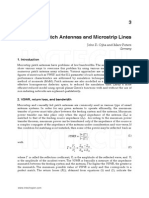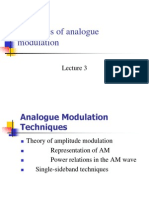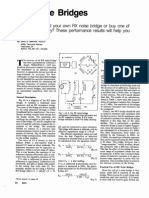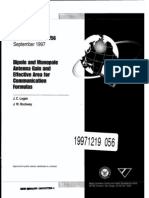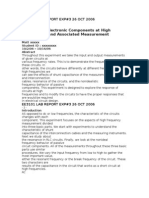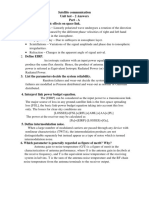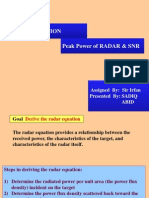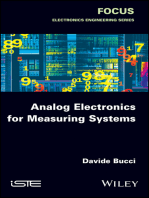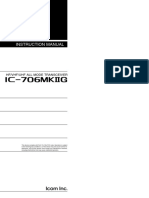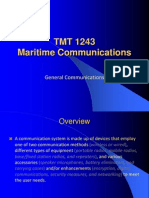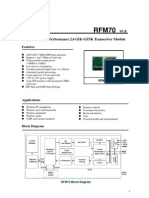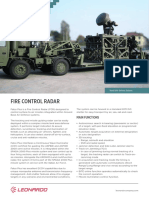Methodology For Analysis of LMR Antenna Systems: Steve Ellingson June 30, 2010
Methodology For Analysis of LMR Antenna Systems: Steve Ellingson June 30, 2010
Uploaded by
seleccion20132013Copyright:
Available Formats
Methodology For Analysis of LMR Antenna Systems: Steve Ellingson June 30, 2010
Methodology For Analysis of LMR Antenna Systems: Steve Ellingson June 30, 2010
Uploaded by
seleccion20132013Original Title
Copyright
Available Formats
Share this document
Did you find this document useful?
Is this content inappropriate?
Copyright:
Available Formats
Methodology For Analysis of LMR Antenna Systems: Steve Ellingson June 30, 2010
Methodology For Analysis of LMR Antenna Systems: Steve Ellingson June 30, 2010
Uploaded by
seleccion20132013Copyright:
Available Formats
Methodology for Analysis of LMR Antenna Systems
Steve Ellingson
June 30, 2010
Contents
1 Introduction 2
2 System Model 2
2.1 Receive System Model . . . . . . . . . . . . . . . . . . . . . . . . . . . . . . . . . . . 2
2.2 Calculation of Transceiver Input-Referred Signal-to-Noise Ratio . . . . . . . . . . . . 5
2.3 Transmit System Model . . . . . . . . . . . . . . . . . . . . . . . . . . . . . . . . . . 5
3 Example: UHF-Band Quarter-Wave Monopole 7
Bradley Dept. of Electrical & Computer Engineering, 302 Whittemore Hall, Virginia Polytechnic Institute &
State University, Blacksburg VA 24061 USA. E-mail: ellingson@vt.edu
1
1 Introduction
Land mobile radio (LMR) refers to wireless communications, typically in the frequency range 30
3000 MHz, in which at least one end of the link is mobile; typically a handheld or vehicle-mounted
transceiver (radio). In the most general terms, the mobile station consists of (1) an antenna, (2) a
transceiver, and (3) an interface consisting of cable and perhaps other devices connecting the
antenna to the transceiver. The primary performance considerations in such a system are dierent
for receiving and transmitting. When receiving, the primary performance consideration is sensitivity;
that is, the relationship between signal-to-noise ratio and incident signal power. When transmitting,
the primary performance considerations are eciency; that is, the fraction of power available from
the transceiver that is successfully radiated by the antenna; and voltage standing wave ratio (VSWR),
which is a measure of extent to which power sourced by the transceiver is reected back into the
transceiver. This report describes a simple methodology for quantifying these considerations in
terms of the characteristics of the antenna, the antenna-transceiver interface, the transceiver, and
the relevant properties of the radio frequency environment.
2 System Model
Dierent but related models are used for the receive and transmit cases.
2.1 Receive System Model
The system model for receive is shown in Figure 1.
Figure 1: Receive system model. Note that it is assumed that the input impedance of the transceiver,
R
R
, is equal to Z
0
, the real-valued reference impedance used for the analysis. Z
0
will typically be
50 .
The antenna is modeled as a voltage source v
A
in series with its self-impedance Z
A
. v
A
is the
voltage across the antenna terminals when open-circuited. Given an incident electric eld E, v
A
is
given by
v
A
= E l
e
(1)
where l
e
is the vector eective length (VEL) of the antenna. Assuming E is co-polarized with l
e
and
we are not concerned with the phase of v
A
, we have the simplied relationship
v
A
= E l
e
(2)
where E and l
e
are the magnitudes of E and l
e
respectively. The eective length l
e
can in principle be
determined experimentally as ratio of v
A
to an applied co-polarized electric eld having magnitude
2
E. However, it is usually more convenient to compute l
e
from the transmit case by applying a test
current to the antenna terminals, and then determining the resulting current distribution over the
antenna; l
e
is then the ratio of the integral of the co-polarized component of the current distribution
over the antenna, to the test current.
The available power P
A
that can be delivered by the antenna into a reectionless matched load
is
P
A
=
|v
A
|
2
4R
A
(3)
where R
A
is the real part of Z
A
and it is assumed that v
A
is measured in RMS volts. Thus the
available power may be written in terms of E:
P
A
= E
2
l
2
e
4R
A
. (4)
It is important to account for noise from the radio frequency environment, as it is possible in
LMR systems for this to be a signicant or dominant component of the system noise. If the signal
received by the antenna is expressed in terms of an antenna temperature T
A
, the corresponding
available power is given by the well-known expression
P
A
= kT
A
B . (5)
where k is Boltzmanns Constant (1.38 10
23
J/K) and B is the bandwidth of interest. T
A
is
property of the radio frequency environment; depending on frequency, time, and location. However,
the minimum possible value can be estimated. In the absence of man-made noise and unusual solar
or atmospheric activity, T
A
in our frequency range of interest is strongly dominated by the Galactic
background noise plus a 2.7 K contribution from the cosmic microwave background (CMB). The
spectrum of the Galactic background is well-understood, and so the antenna temperature can be
approximately lower-bounded by
T
A
9000
_
f
38 MHz
_
2.52
+ 2.7 K (6)
where f is frequency [1]. Thus, we see that the lower bound on T
A
is approximately 9000 K at
38 MHz, dropping to just a few K at 1 GHz. It should be noted that this minimum level actually
uctuates on the order of a few dB due to rotation of the Earth with respect to the spatially-varying
Galactic brightness temperature distribution.
Man-made noise can be modeled in a similar way; in fact, it is useful to know that the man-made
radio noise spectrum in the LMR bands also exhibits a power-law spectral dependence with approx-
imately the same exponent, with the primary dierence being simply that the leading coecient is
greater [2, 3].
We now consider P
R
, the power delivered to the transceiver. This is given by
P
R
= Re
_
v
+
R
_
i
+
R
_
_
(7)
where v
+
R
is the voltage wave traveling into the transceiver, i
+
R
is the corresponding current wave,
and we continue to use RMS quantities. Since i
+
R
= v
+
R
/R
R
, we have
P
R
=
v
+
R
2 1
R
R
(8)
Now consider a situation in which the antenna is terminated directly into a load impedance equal
to R
R
, and let v
+
A
be dened as the voltage wave traveling into the load in this case. Then
v
+
A
= v
A
R
R
Z
A
+ R
R
. (9)
3
We use this to manipulate our expression for P
R
as follows:
P
R
=
v
+
R
v
+
A
v
+
A
2 1
R
R
=
v
+
R
v
+
A
2
|v
A
|
2
R
R
Z
A
+ R
R
2
1
R
R
, (10)
and using Equation 3, we obtain
P
R
= P
A
v
+
R
v
+
A
2
4R
A
R
R
|Z
A
+ R
R
|
2
. (11)
The factor
v
+
R
/v
+
A
2
can be conveniently expressed in terms of the s-parameters
1
of the antenna-
transceiver interface stage (i.e., cable and other devices, as dened in Figure 1). To accomplish this,
we take R
R
to be the real-valued reference impedance Z
0
with respect to which the s-parameters
and associated reection coecients are calculated. We then have:
P
R
= P
A
s
21
1 s
11
2
4R
A
Z
0
|Z
A
+ Z
0
|
2
. (12)
where
A
is the voltage reection coecient looking into the antenna from a termination of impedance
Z
0
; i.e.,
A
=
Z
A
Z
0
Z
A
+ Z
0
(13)
Equation 12 can be used with Equations 4 and 5 to compute the contributions of a deliberate signal
and environmental noise, respectively, to the total power delivered to the transceiver.
A common situation is that the antenna-transceiver interface will consist simply of a coaxial
cable which connects the antenna output to the transceiver input. In this case, the associated
s-parameters for a cable having characteristic impedance equal to the standard impedance Z
0
are:
s
12
= s
21
= e
l
, and (14)
s
11
= s
22
= 0 ; where (15)
=
f
f
0
+ j
2f
v
f
c
, (16)
where l is length, is the attenuation constant, f
0
is the frequency at which is determined, and
v
f
is the velocity factor. The s-parameters for more complicated interfaces including those con-
sisting of combinations of cables, lters, ampliers, couplers, and so on can be determined using
well-known theory and/or measurement techniques [4].
At this point the only noise we have accounted for is the noise contributed by the environment.
Additional noise sources include thermal noise associated with ohmic loss in the antenna-transceiver
interface, and noise contributed by the transceiver itself.
2
The former can be computed using
expressions reported by [5], which can be summarized in our case as follows:
N
T
= kT
p
B
_
_
1
_
1 |
A
|
2
_
|s
21
|
2
1 s
11
A
_
_
, (17)
where T
p
is the ambient physical temperature of the antenna-transceiver interface. Note that for the
commonly-assumed special case
A
= 0, this reduces to the well-known expression for the output-
referred noise power produced by a lossy stage in an RF system cascade.
1
A recommended reference on s-parameters which is particularly well-suited to the analysis described here is [4].
2
This is the noise normally quantied by the transceivers noise gure.
4
Finally, we consider the self-noise of the transceiver. This can be inferred from the specied
sensitivity of the transceiver as follows. For transceivers operating in analog FM mode, it is common
to specify sensitivity as the power at the input which produces an audio output equal to a given
SINAD; for example, the TIA-603 specication is 116 dBm for 12 dB SINAD [6]. It can be shown
that for the 12.5 kHz bandwidth variant of analog FM, 12 dB audio SINAD requires an RF signal-
to-noise ratio of 6.5 dB (see Appendix A of [3] for a derivation). Thus, the noise power at the
transceiver input must be 116 6.5 = 122.5 dBm (in 12.5 kHz) at the threshold of sensitivity in
this case. This corresponds to a noise power spectral density of about 4.5 10
20
W/Hz. Similar
calculations can be made of other transceivers using either specied or measured sensitivity.
2.2 Calculation of Transceiver Input-Referred Signal-to-Noise Ratio
As stated in Section 1, our primary consideration when receiving is signal-to-noise ratio referenced
to the input of the transceiver, which can be calculated in terms of the receive system model dened
in the previous section as
S
N
=
S
N
E
+ N
T
+ N
R
(18)
where
S is the power of the desired signal which is delivered to the transceiver, which is given by
Equations 12 and 4. Summarizing:
S = E
2
l
2
e
4R
A
s
21
1 s
11
2
4R
A
Z
0
|Z
A
+ Z
0
|
2
. (19)
N
E
is the power associated with environmental noise which is delivered to the transceiver,
which is given by Equations 12 and 5. Summarizing:
N
E
= kT
A
B
s
21
1 s
11
2
4R
A
Z
0
|Z
A
+ Z
0
|
2
, (20)
where T
A
is approximately lower-bounded by Equation 6 and can be determined for other
environments as described in [2] or [3].
N
T
is the power associated with thermal noise due to ohmic losses in the antenna-transceiver
interface and which is delivered to the transceiver, which is given by Equation 17.
N
R
is the input-referred noise power generated by the transceiver itself. As explained above,
this is about 4.5 10
20
W/Hz times B for a transceiver operating at the TIA-603-specied
sensitivity for B = 12.5 kHz analog FM, and can be similarly computed for actual receivers or
other modes.
2.3 Transmit System Model
The system model for transmit is shown in Figure 2. Note that the model is the same as for receive,
except that the antenna is now modeled as a simple load having impedance Z
A
, the transceiver is
modeled as a source of power P
T
incident on the 2 port of the antenna-transceiver interface from
an impedance Z
0
, and the desired direction of power ow is obviously from right to left. Note that
the meanings of all parameters in the transmit model retain the same meanings as in the receive
model, including the denitions of the s-parameters for the antenna-transceiver interface.
As stated in Section 1, the two parameters of interest in the transmit case are eciency and
VSWR. The VSWR for the transceivers input to the system is given by
VSWR =
1 +|
2
|
1 |
2
|
, (21)
5
Figure 2: Transmit system model. The transceiver is assumed to be providing power P
T
incident on
the antenna-transceiver interface. Note that the denitions of the 1 and 2 ports for s-parameter
denitions is unchanged from the receive system model.
where
2
, the voltage reection coecient looking into the input of the antenna-transceiver interface
from the output of the transceiver, is given by
2
= s
22
+
s
12
s
21
A
1 s
11
A
. (22)
For transmit eciency, many denitions are possible. Here, we consider two. First, we dene
the total transmit power eciency
T
as the ratio of the total power successfully radiated by the
antenna; to P
T
, the power that would be delivered by the transceiver into a reectionless matched
load. The derivation is very similar to that used to obtain Equation 12, and the result is:
T
=
s
12
1 s
11
2 _
1 |
A
|
2
_
. (23)
Second, we dene the antenna pattern-modied transmit power eciency
TA
as
T
times the
directive gain D
H
of the antenna in the direction of the horizon; i.e., for zero elevation. Note that
TA
=
T
for an isotropic antenna, but in practice
TA
will be typically be greater than
T
by a
few dB, corresponding to the directivity of an LMR mobile antenna in the direction of the horizon.
It is also useful to note that
TA
is equal to the eective isotropic radiated power (EIRP) in the
direction of the horizon, divided by the power that the transceiver can deliver into a reectionless
matched load. The benet of computing
TA
in addition to
T
is that the former is more closely
related to link range, and thus is closer to facilitating a bottom-line, apples-to-apples comparison
between systems using the same transceivers but dierent antennas and antenna-transceiver inter-
faces. However, when there is uncertainty about D
H
, or in situations where horizon directivity is
not necessarily the most relevant concern (e.g., in urban or mountainous environments), then
T
is
probably a better metric of transmit eciency. Thus, both
T
and
TA
are useful.
D
H
can be computed in a number of ways. Since we require the eective length l
e
for the receive
analysis, it is convenient to recycle that result to obtain an expression for D
H
. To do this, we note
6
that the eective aperture A
e
of an antenna can be expressed in terms of l
e
, as follows:
A
e
=
l
2
e
4
R
A
|Z
A
|
2
(24)
where is the impedance of free space ( 377 ). In terms of D
H
, we have:
A
e
= D
H
2
4
, (25)
where is wavelength. Combining these equations we nd:
D
H
=
R
A
|Z
A
|
2
_
l
e
_
2
. (26)
Of course, D
H
can also be obtained from an analysis or measurement of the antenna pattern.
3 Example: UHF-Band Quarter-Wave Monopole
In this section we present an example of a simple but commonly-considered antenna system to
demonstrate the methodology described in the previous sections of this report. The antenna is a
monopole of height h = 15.7 cm and radius a = 1 mm, over an innite perfectly-conducting ground
plane, designed to have a quarter-wavelength resonance at 453 MHz. The antenna is connected
to the transceiver through RG-58 coaxial cable having length 5.18 m (17 ft). The transceiver is
assumed to be operating in an analog FM mode with bandwidth B = 12.5 kHz. The remaining
details of the system model are as follows:
The antenna self-impedance Z
A
is obtained by rst calculating the theoretical impedance of a
dipole having length 2h and radius a, using a method described in [7]. Invoking image theory,
the actual value of Z
A
is then taken to be one-half this value.
The antenna eective length l
e
is calculated from the ideal sinusoidal current distribution for
the corresponding image dipole of length 2h:
I(z) = I(0)
sin (2 (h z) /)
sin (2h/)
(27)
for h z h, using the method described in Section 2.1.
The cable is modeled as described in Equations 1416, with = 0.00553 m
1
at f
0
= 10 MHz,
and v
f
= 0.66 (representing RG-58 coaxial cable).
The lower-bound environmental noise model described in Equation 6 is used.
The assumed ambient physical temperature is T
p
= 293 K.
The assumed input-referred noise power spectral density of the transceivers receiver is 4.5
10
20
W/Hz, corresponding to the TIA-603-specied sensitivity, as suggested in Section 2.1.
The co-polarized incident electric eld magnitude E was set to achieve S/N = 12.5 dB at the
input of the transceiver at 453 MHz, under the conditions of the system model and parameters
given above. This is 6 dB greater than the minimum 6.5 dB determined in Section 2.1 to be
required to achieve the TIA-603 sensitivity specication. The resulting value is found to be
E = 7.2 V/m. This value is used as the incident signal strength, independent of frequency.
The results are shown in Figures 3 (S/N delivered to receiver), 4 (transmit VSWR) and 5 (trans-
mit eciency). Also, Table 1 shows a numerical summary of performance. Further observations
about this antenna system are summarized as follows:
7
Receive
Co-pol. E required to exceed TIA-603 sensitivity by 6 dB 7.2 V/m RMS
Bandwidth over which S/N is greater than 3 dB below peak 161 MHz
Transmit
Bandwidth over which transmit VSWR < 2:1 95 MHz
Max. radiated power relative to power available from transmitter (
T
) 1.9 dB
Max. horizon EIRP relative to power available from transmitter (
TA
) +3.3 dB
Bandwidth over which
TA
is within 3 dB of peak 65 MHz
Table 1: Quarter-wavelength monopole example: Summary.
Note that tuning range for acceptable sensitivity is greater than the tuning range for reason-
able transmit VSWR, and much greater than the tuning range over which
TA
is close to its
nominal value. Said simply, the useful bandwidth for receiving is much greater than the useful
bandwidth for transmitting.
Note in Figure 5 that the dierence between the two curves is equal to D
H
, the directive
gain in the direction of the horizon. The peak dierence is about 5 dB, corresponding to the
nominal D
H
of an ideal quarter-wavelength monopole. As the frequency is varied from this
nominal value, both D
H
and the transmit eciency (
T
) are reduced.
Figure 6 shows the desired signal power and the various noise components contributing to the
S/N result shown in Figure 3, individually. Note that the total noise is strongly dominated
by the transceivers self-noise, and that the environmental noise and antenna system thermal
noise are relatively weak. (The dip in the thermal noise around resonance is because under
this condition thermal noise from the cable can eciently be radiated out the antenna as well
as into the receiver.) Said dierently, the system S/N could be improved dramatically by
improving the sensitivity of the transceiver itself. In fairness, it should be noted that there
are signicant technical barriers to doing this in practice; large among them is the tradeo
between receiver sensitivity and intermodulation performance.
8
-10
-5
0
5
10
15
100 200 300 400 500 600 700 800 900
S
/
N
[
d
B
]
Frequency [MHz]
Figure 3: Quarter-wavelength monopole example: S/N delivered to receiver.
9
1
2
3
4
5
6
100 200 300 400 500 600 700 800 900
V
S
W
R
Frequency [MHz]
Figure 4: Quarter-wavelength monopole example: Transmit VSWR.
10
-10
-5
0
5
10
100 200 300 400 500 600 700 800 900
[
d
B
]
Frequency [MHz]
T
[dB]
TA
[dBi]
Figure 5: Quarter-wavelength monopole example: Transmit eciency
T
and antenna pattern-
modied transmit eciency
TA
.
11
-170
-160
-150
-140
-130
-120
-110
100 200 300 400 500 600 700 800 900
[
d
B
m
]
Frequency [MHz]
S
N
E
N
T
N
R
Figure 6: Quarter-wavelength monopole example: Signal power and the various noise components
contributing to the S/N result shown in Figure 3, shown individually.
12
References
[1] S. W. Ellingson, Antennas for the Next Generation of Low Frequency Radio Telescopes, IEEE
Trans. Ant. & Prop., Vol. 53, No. 8, August 2005, pp. 24809.
[2] International Telecommunication Union, Radio Noise, P.372-8, 2003.
[3] S. M. Shajedul Hasan, New Concepts in Front End Design for Receivers with Large, Multiband
Tuning Ranges, Ph.D. Dissertation, Virginia Polytechnic Inst. & State U., 2009.
[4] Agilent Technologies, S-Parameter Design, Application Note AN 154, 2006.
[5] C. K. S. Miller, W. C. Daywitt, & M. G. Arthur, Noise Standards, Measurements, and Receiver
Noise Denitions, Proc. IEEE, Vol. 55, No. 6, June 1967, pp. 86577.
[6] Telecommunications Industry Association, TIA Standard: Land Mobile FM or PM Commu-
nications Equipment Measurement and Performance Standards, TIA-603-C, December 2004.
[7] S. J. Orfandis, Electromagnetic Waves and Antennas, [online] www.ece.rutgers.edu/
orfanidi/ewa. Section 22.3 (Self and Mutual Impedance), including associated Matlab
source code, of Chapter 22 (Coupled Antennas), Apr 28, 2010.
13
You might also like
- Translines ProjectDocument8 pagesTranslines ProjectOdellien SajaNo ratings yet
- 4x4 Antenna ArrayDocument15 pages4x4 Antenna ArraySilent_Assasin100% (1)
- 1 Theory: 1.1 Coplanar 2d-Waveguide StructuresDocument9 pages1 Theory: 1.1 Coplanar 2d-Waveguide StructuresSebastianMeierNo ratings yet
- AWP NotesDocument76 pagesAWP NotesSebastin SureshNo ratings yet
- Power Received by A Small Antenna: Joseph Henry Laboratories, Princeton University, Princeton, NJ 08544Document16 pagesPower Received by A Small Antenna: Joseph Henry Laboratories, Princeton University, Princeton, NJ 08544nNo ratings yet
- E and ADocument11 pagesE and AMinal SatheNo ratings yet
- Ece 3323 Experiment 1Document11 pagesEce 3323 Experiment 1TANQUERO_WW20% (2)
- Transmission Lines (Complete)Document14 pagesTransmission Lines (Complete)Floyd SampianoNo ratings yet
- Lecture 2Document8 pagesLecture 2Mustafa Khider100% (1)
- Mm-Wave Radiometers: Thermal EmissionDocument34 pagesMm-Wave Radiometers: Thermal EmissionasdfasdfsafdasfsaNo ratings yet
- Lec 2 TelecomDocument33 pagesLec 2 Telecommussaab.niassNo ratings yet
- Experiment 7. Wave PropagationDocument9 pagesExperiment 7. Wave PropagationAlex TrinhNo ratings yet
- Antennas and Wave PropagationDocument34 pagesAntennas and Wave PropagationRao AneesNo ratings yet
- Antenna NOl PDFDocument77 pagesAntenna NOl PDFVenkataramanLakshminarayananNo ratings yet
- Field Strength and Power EstimatorDocument16 pagesField Strength and Power EstimatorStarLink1No ratings yet
- Comparison of Rayleigh and Rician Fading Channel Under Frequency PDFDocument4 pagesComparison of Rayleigh and Rician Fading Channel Under Frequency PDFsrikar01No ratings yet
- Principles of Analogue ModulationDocument23 pagesPrinciples of Analogue ModulationUmang AggarwalNo ratings yet
- WCC Module-1 NotesDocument33 pagesWCC Module-1 Notessadiqul azamNo ratings yet
- Microwave Note 11Document94 pagesMicrowave Note 11Rayan NezarNo ratings yet
- Antenna Lect6 EXDocument60 pagesAntenna Lect6 EXMohamed TwatiNo ratings yet
- Probsetreso 1Document34 pagesProbsetreso 1Edmark AldeaNo ratings yet
- Antenna Engineering by HaytDocument4 pagesAntenna Engineering by HaytKhajavali ShaikNo ratings yet
- RX Noise Bridges Belrose - 1988 05Document3 pagesRX Noise Bridges Belrose - 1988 05Raluca CiorceriNo ratings yet
- Complex Simulation Model of Mobile Fading Channel: Tomáš Marek, Vladimír Pšenák, Vladimír WieserDocument6 pagesComplex Simulation Model of Mobile Fading Channel: Tomáš Marek, Vladimír Pšenák, Vladimír Wiesergzb012No ratings yet
- Dipole and Mono Pole Antenna GainDocument19 pagesDipole and Mono Pole Antenna Gainbmmarko5483No ratings yet
- Impedance Matching N TransformationDocument51 pagesImpedance Matching N TransformationShreya AdhikariNo ratings yet
- Transmission LinesDocument5 pagesTransmission LinesEchizen KinichiNo ratings yet
- Spring ConstantDocument17 pagesSpring Constantamanda1810No ratings yet
- 2019 Problems in Electromagnetics Vol 1Document35 pages2019 Problems in Electromagnetics Vol 1soumengoswami10No ratings yet
- ALTAE 2009 Velasquez Kraetge ENUDocument6 pagesALTAE 2009 Velasquez Kraetge ENUInsan AzizNo ratings yet
- A Calibration Method For Small Circular LoopDocument5 pagesA Calibration Method For Small Circular LoopaartrajNo ratings yet
- Rohini 89467868776Document13 pagesRohini 89467868776pravinmathan127No ratings yet
- Dr. Yahya AliDocument14 pagesDr. Yahya AliSakena AbbasNo ratings yet
- Ant part 3Document42 pagesAnt part 3ejamal288No ratings yet
- Ee3101 Lab Report ExpDocument16 pagesEe3101 Lab Report ExpyucesNo ratings yet
- 2.2 Antenna ParametersDocument5 pages2.2 Antenna ParametersAdos OchiaNo ratings yet
- Antena - L4 - Input Impedance of Antenna2023Document9 pagesAntena - L4 - Input Impedance of Antenna2023مؤمل عبدالهاديNo ratings yet
- An AntennaDocument11 pagesAn AntennaKwesi MensahNo ratings yet
- An-791 A Simplified Approach To VHF Power Amplifier DesignDocument10 pagesAn-791 A Simplified Approach To VHF Power Amplifier DesignEdward YanezNo ratings yet
- A Revisitation of The 1888 H.Hertz Experiment: PACS NumbersDocument3 pagesA Revisitation of The 1888 H.Hertz Experiment: PACS NumbersNela_MS93No ratings yet
- Pulses in Cables: ReferencesDocument5 pagesPulses in Cables: ReferencesPaul DumitruNo ratings yet
- Resonant AntennasDocument27 pagesResonant Antennasrakesh hudedNo ratings yet
- Satellite Communication Unit Test - 2 Answers Part - A 1. List The Ionospheric Effects On Space LinkDocument9 pagesSatellite Communication Unit Test - 2 Answers Part - A 1. List The Ionospheric Effects On Space LinkDivyaNo ratings yet
- 6-Alculation of System Noise Temperature G - T Ratio For Earth Stations - Link Budgets - Uplink and Down-22-10-2021 (22-Oct-2021) MateriDocument37 pages6-Alculation of System Noise Temperature G - T Ratio For Earth Stations - Link Budgets - Uplink and Down-22-10-2021 (22-Oct-2021) MateriGUNNSNo ratings yet
- Amplitude Modulation:: Baseband and Carrier CommunicationDocument7 pagesAmplitude Modulation:: Baseband and Carrier CommunicationAnil RaiNo ratings yet
- Standing Wave Ratio: Relationship To The Reflection CoefficientDocument5 pagesStanding Wave Ratio: Relationship To The Reflection Coefficientpreethy.wilsNo ratings yet
- Factor QDocument7 pagesFactor QMilton AyalaNo ratings yet
- EC2353 - Antenna and Wave PropagationDocument76 pagesEC2353 - Antenna and Wave PropagationTushar vaswaniNo ratings yet
- 4.EE 8208 FREQUENCY RESPONCE-Lecture 44Document91 pages4.EE 8208 FREQUENCY RESPONCE-Lecture 44ANDREW GIDIONNo ratings yet
- Antenna Temperature (: Radiation PatternDocument30 pagesAntenna Temperature (: Radiation PatternAnkit JaiswalNo ratings yet
- Radar Equation2Document25 pagesRadar Equation2Zeeshan KhanNo ratings yet
- Numerical EvaluatorDocument3 pagesNumerical EvaluatordbsmileNo ratings yet
- Coupling Between HF-AntennasDocument5 pagesCoupling Between HF-AntennasbaluNo ratings yet
- Evaluation of The Ultrasonic Transducer Electrical Matching PerformanceDocument6 pagesEvaluation of The Ultrasonic Transducer Electrical Matching PerformancegrezmosNo ratings yet
- Experiment 2 - Vector Network Analyzer MeasurementDocument25 pagesExperiment 2 - Vector Network Analyzer MeasurementBadut234No ratings yet
- 2 Marks With AnswerDocument9 pages2 Marks With AnswerMaha MurthyNo ratings yet
- Feynman Lectures Simplified 2C: Electromagnetism: in Relativity & in Dense MatterFrom EverandFeynman Lectures Simplified 2C: Electromagnetism: in Relativity & in Dense MatterNo ratings yet
- Sure Fi Relay CutsheetDocument2 pagesSure Fi Relay CutsheetalinaNo ratings yet
- CE Project-WheelchairDocument24 pagesCE Project-WheelchairHemanth YenniNo ratings yet
- ICOM IC-9700 BrochureDocument2 pagesICOM IC-9700 BrochurescsehNo ratings yet
- Simple 12AT7 Super Regenerative FM Tuner ECC81Document3 pagesSimple 12AT7 Super Regenerative FM Tuner ECC81smang10No ratings yet
- Trimble R4 PDFDocument75 pagesTrimble R4 PDFJavier Vinicio Yupangui GuanucheNo ratings yet
- Discussion Forum Unit 1Document3 pagesDiscussion Forum Unit 1Firew AberaNo ratings yet
- Antenna System SupervisionDocument38 pagesAntenna System SupervisionsmacreadNo ratings yet
- RF ChainDocument82 pagesRF ChainbharanidharanNo ratings yet
- Broadcasting MidtermDocument28 pagesBroadcasting MidtermJohn Randall RamosNo ratings yet
- 1 12 Module in Mil 11 Quarter 1 Melc 1Document16 pages1 12 Module in Mil 11 Quarter 1 Melc 1jenny feNo ratings yet
- Tsop 2236Document8 pagesTsop 2236Alberto LimónNo ratings yet
- Crystal Radio CircuitsDocument11 pagesCrystal Radio CircuitsSubimal BawaliNo ratings yet
- Find'n'Secure Find'n'Secure Find'n'Secure: Automatic Tracking & Security SoftwareDocument8 pagesFind'n'Secure Find'n'Secure Find'n'Secure: Automatic Tracking & Security SoftwareBhaskar BhattNo ratings yet
- Redefined: Performance and ProductivityDocument2 pagesRedefined: Performance and Productivitysoffter2000No ratings yet
- Ic 706MK2G PDFDocument75 pagesIc 706MK2G PDFJose JullianNo ratings yet
- BeamDocument2 pagesBeamMitsubishi FA Riyadh-Saudi ArabiaNo ratings yet
- 01 General CommunicationDocument79 pages01 General CommunicationLuqman AfiqNo ratings yet
- Design of A Real Time Smart Honking SystemDocument6 pagesDesign of A Real Time Smart Honking SystemArka MajumdarNo ratings yet
- Optical Communication Systems For Smart DustDocument72 pagesOptical Communication Systems For Smart DustHarsh SinghNo ratings yet
- Amplificador Retekess TR619-English (Oct-2020)Document1 pageAmplificador Retekess TR619-English (Oct-2020)josefm665699No ratings yet
- RAN1308: HSUPA Interference Cancellation ReceiverDocument12 pagesRAN1308: HSUPA Interference Cancellation Receivermrz_naghaviNo ratings yet
- RFM70Document26 pagesRFM70Stefano FerrarisNo ratings yet
- Data and Computer CommunicationsDocument33 pagesData and Computer CommunicationsShah Amran NayanNo ratings yet
- Quick Manual SNS 1tDocument4 pagesQuick Manual SNS 1tMeini HarijantoNo ratings yet
- Falco Plus Fire Control Radar LQ Mm08809Document2 pagesFalco Plus Fire Control Radar LQ Mm08809Karthick MeenaNo ratings yet
- Mat Previous Year Papers SolvedDocument19 pagesMat Previous Year Papers SolvedbhavanaNo ratings yet
- New Production Development: Name: Muhammad Noor Amirullah Bin Azizuddin NO MATRIX: CB200191Document20 pagesNew Production Development: Name: Muhammad Noor Amirullah Bin Azizuddin NO MATRIX: CB200191noor amirullahNo ratings yet
- New World Order and E.L.F. Psychotronic TyrannyDocument18 pagesNew World Order and E.L.F. Psychotronic TyrannyKeith KnightNo ratings yet
- SWM 1984 06Document52 pagesSWM 1984 06paulNo ratings yet
- Manual Telecomanda Midea Xtreme Eco 2022Document16 pagesManual Telecomanda Midea Xtreme Eco 2022Mario LeancăNo ratings yet

